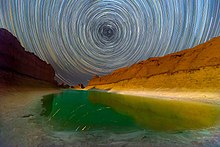Star trail
Star trail photographs are captured by placing a camera on a tripod, pointing the lens toward the night sky, and allowing the shutter to stay open for a long period of time.
Typical exposure times range from 15 minutes to many hours long, depending on the desired length of the star trail arcs for the image.
[5][8] Because exposure times for star trail photographs can be several hours long, camera batteries can be easily depleted.
American astronaut Don Pettit recorded star trails with a digital camera from the International Space Station in Earth orbit between April and June, 2012.
However, with modern digital cameras, 30 seconds is about the longest exposure possible, due to electronic detector noise effectively snowing out the image.
[5] For observers in the Northern Hemisphere, aiming the camera northward creates an image with concentric circular arcs centered on the north celestial pole (very near Polaris).
Aiming the camera eastward or westward shows straight streaks on the celestial equator, which is tilted at angle with respect to the horizon.





